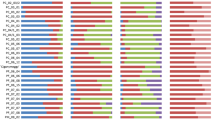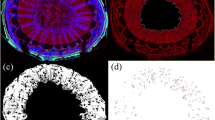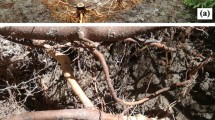Abstract
Current fruit production, relays on rootstocks that are size-controlling, productive and precocious. However, facing uneven precipitation distribution and long drought events, rootstocks’ breeding goals should shift towards genotypes with roots promptly responding to the water availability. Thus, this study aimed to determine the root anatomical responses to the occurrence of drought episode (39 days) followed by the excessive precipitation event (113.6 mm in four days). Plant material included three cherry species and interspecific hybrid: Prunus cerasus, Prunus fruticosa, Prunus mahaleb and ‘Gisela 5’ (P. cerasus × Prunus canescens). Detailed anatomical analysis included root samples with the differentiated secondary structure taken from the sampling depth of 10–15 cm. The roots were to varying degrees affected by the precipitation and number of dry days, but all responded with the occurrence of the ‘false’ outer ring, after the excessive precipitation event. Furthermore, within all three species, a very clear pattern of vessel size production was observed: the inner ˃ the middle < the outer (newly formed) zone vessels, whilst in the interspecific hybrid this pattern could not be determined. Effective crown volumes measured in vegetations preceding (2021) and succeeding the drought episode (2022), indicated that trees grafted on P. cerasus, P. fruticosa and P. mahaleb genotypes fully recovered and achieved normal vegetative growth rates (≈30%), while trees on the ‘Gisela 5’ ceased their development (less than 10%). Our study indicates that indigenous germplasm can contribute to the substantial selection of genotypes successfully adapting to drought and rain episodes.



Similar content being viewed by others
Data Availability
All data related to this research are available for research purposes from the corresponding authors upon request. The datasets used and/or analyzed during the current study are available as supplement and/or from the corresponding author on reasonable request.
Code Availability
Not applicable.
References
Arend M, Fromm J (2007) Seasonal change in the drought response of wood cell development in poplar. Tree Physiol 27:985–992
Baas P, Ewers FW, Davis SD, Wheeler EA (2004) Evolution of xylem physiology. In: Hemsley AR, Poole I (eds) The Evolution of Plant Physiology. Elsevier Academic Press, London, UK; San Deigo, CA, USA, pp 273–295
Balducci L, Deslauriers A, Giovannelli A, Rossi S, Rathgeber CB (2013) Effects of temperature and water deficit on cambial activity and woody ring features in Picea mariana saplings. Tree Physiol 33(10):1006–1017
Battipaglia G, De Micco V, Brand WA, Linke P, Aronne G, Saurer M, Cherubini P (2010) Variations of vessel diameter and δ13C in false rings of Arbutus unedo L. reflect different environmental conditions. New Phytol 188:1099–1112
Begum S, Kudo K, Rahman MH, Nakaba S, Yamagishi Y, Nabeshima E, Nugroho WD, Oribe Y, Kitin P, Jin HO, Funada R (2017) Climate change and the regulation of wood formation in trees by temperature. Trees 32(1):3–15
Brunner I, Herzog C, Dawes MA, Arend M, Sperisen C (2015) How tree roots respond to drought. Front Plant Sci 6:547
Bryukhanova M, Fonti P (2013) Xylem plasticity allows rapid hydraulic adjustment to annual climatic variability. Trees 27(3):485–496
Castagneri D, Petit G, Carrer M (2015) Divergent climate response on hydraulic-related xylem anatomical traits of Picea abies along a 900-m altitudinal gradient. Tree Physiol 35(12):1378–1387
Changok L. 2007. Estimation of urban tree crown volume based on object-oriented approach and lidar data. Master’s Thesis, International Institute for Geoinformation Science and Earth Observation, Enschede, The Netherlands.
Cherubini P, Gartner BL, Tognetti R, Bräker OU, Schoch W, Innes JL (2003) Identification, measurement and interpretation of tree rings in woody species from Mediterranean climates. Biol Rev 78(1):119–148
Curtu AL, Alizoti P, Ballian D (2018) Marginal/peripheral populations of forest tree species and their conservation status: Report for southeastern Europe. Annal Silvicultural Res 41:42–47
De Luis M, Novak K, Raventós J, Gričar J, Prislan P, Čufar K (2011) Cambial activity, wood formation and sapling survival of Pinus halepensis exposed to different irrigation regimes. For Ecol Manage 262(8):1630–1638
Egner H, Riehm H, Domingo WR (1960) Investigations of the chemical soil analysis as a basis for the evaluation of nutrient status in soil. II. Chemical extraction methods for phosphorus and potassium determination. Kungliga Lantbrukshügskolans Annaler 26:195–215
Eilmann B, Zweifel R, Buchmann N, Fonti P, Rigling A (2009) Drought induced adaptation of xylem in Scots pine and pubescent oak. Tree Physiol 29:1011–1020
Fonti P, Jansen S (2012) Xylem plasticity in response to climate. New Phytol 195(4):734–736
Fonti P, von Arx G, García-González I, Eilmann B, Sass-Klaassen U, Gärtner H, Eckstein D (2010) Studying global change through investigation of the plastic responses of xylem anatomy in tree rings. New Phytol 185(1):42–53
Gea-Izquierdo G, Fonti P, Cherubini P, Martín-Benito D, Chaar H, Cañellas I (2012) Xylem hydraulic adjustment and growth response of Quercus canariensis Willd to climatic variability. Tree Physiol 32(4):401–413
Geng D, Chen P, Shen X, Zhang Y, Li X, Jiang L, Xie Y, Niu C, Zhang J, Huang X, Ma F, Guan Q (2018) MdMYB88 and MdMYB124 enhance drought tolerance by modulating root vessels and cell walls in apple. Plant Physiol 178(3):1296–1309
Hajagos A, Végvári G (2013) Investigation of tissue structure and xylem anatomy of eight rootstocks of sweet cherry (Prunus avium L.). Trees 27(1):53–60
Hargrave KR, Kolb KJ, Ewers FW, Davis SD (1994) Conduit diameter and drought-induced embolism in Salvia mellifera Greene (Labiatae). New Phytol 126(4):695–705
Hernandez-Espinoza LH, Barrios-Masias FH (2020) Physiological and anatomical changes in tomato roots in response to low water stress. Sci Hortic 265:109208
Iezzoni AF, Schmidt H, Albertini A. 1991. Cherries (Prunus). In: Moore JN, Ballington JrJR (Eds), Genetic Resources of Temperate Friut and Nut Crops. ISHS Wageningen.1: 109–173.
ISO, International Organization for Standardization. (2005). ISO 10693:2005, Soil quality Determination of carbonate content - Volumetric method
ISO, International Organization for Standardization. (2007). ISO 10390:2007, Soil quality Determination of pH
Li B, Xie Z, Zhang A, Xu W, Zhang C, Liu Q, Liu C, Wang S (2010) Tree growth characteristics and flower bud differentiation of sweet cherry (Prunus avium L.) under different climate conditions in China. Horticul Sci (prague) 37:6–13
Ljubojević M, Ognjanov V, Zorić L, Maksimović I, Merkulov L, Bošnjaković D, Barać G (2013) Modeling of water movement trough cherry plant as preselecting tool for prediction of tree vigor. Sci Hortic 160:189–197
Ljubojević M, Zorić L, Maksimović I, Dulić J, Miodragović M, Barać G, Ognjanov V (2017) Anatomically assisted cherry rootstock selection. Sci Hortic 217:197–208
Ljubojević M, Maksimović I, Lalić B, Dekić L, Narandžić T, Magazin N, Dulić J, Miodragović M, Barać G, Ognjanov V (2018) Environmentally-related cherry root cambial plasticity. Atmosphere 9(9):358
Ljubojević M, Sebolt A, Ognjanov V, Iezzoni A (2022) Heritability of anatomical characteristics in cherry interspecific hybrids. J Plant Growth Regul 41:965–982
Lovisolo C, Schubert A (1998) Effects of water stress on vessel size and xylem hydraulic conductivity in Vitis vinifera L. J Exp Bot 49(321):693–700
Lynch JP (2022) Harnessing root architecture to address global challenges. Plant J 109:415–431
Lynch JP, Strock CF, Schneider HM, Sidhu JS, Ajmera I, Galindo-Castañeda T, Klein SP, Hanlon MT (2021) Root anatomy and soil resource capture. Plant Soil 466(1):21–63
Mičurin IV. 1948. Annals in IV tomes. In: Lisenko TD (Ed.) Ogiz, Selhozgiz, Moscow, USSR. 715 pp. (In Russian).
Miljković NS. 1996. Fundamentals of pedology. Novi Sad: Institute of geography, Faculty of Natural Sciences (in Serbian).
Mratinić E, Kojić M. 1998. Wild Fruit Species of Serbia. Agricultural Research Institute ‘SERBIA’, Belgrade, Serbia. 375 pp.
Narandžić T, Ljubojević M (2022) Size-controlling cherry rootstock selection based on root anatomical characteristics. Horticulturae 8(7):615
Ognjanov V, Ljubojević M, Ninić-Todorović J, Bošnjaković D, Barać G, Čukanović J, Mladenović E (2012) Morphometric diversity in dwarf sour cherry germplasm in Serbia. J Hortic Sci Biotechnol 87(2):117–122
Predieri S, Dris R, Sekse L, Rapparini F (2003) Influence of environmental factors and orchard management on yield and quality of sweet cherry. Food Agri Environ 1:263–266
Rossi S, Deslauriers A, Anfodillo T (2006) Assessment of cambial activity and xylogenesis by microsampling tree species: An example at the Alpine timberline. IAWA J 27:383–394
Rossi S, Deslauriers A, Griçar J, Seo JW, Rathgeber CB, Anfodillo T, Morin H, Levanic T, Oven P, Jalkanen R (2008) Critical temperatures for xylogenesis in conifers of cold climates. Glob Ecol Biogeogr 17(6):696–707
Rossi S, Simard S, Rathgeber CBK, Deslauriers A, De Zan C (2009) Effects of a 20-day-long dry period on cambial and apical meristem growth in Abies balsamea seedlings. Trees 23:85–93
Schwinning S, Ehleringer JR (2001) Water use trade-offs and optimal adaptations to pulse-driven arid ecosystems. J Ecol 89(3):464–480
Shoaib M, Banerjee BP, Hayden M, Kant S (2022) Roots’ drought adaptive traits in crop improvement. Plants 11(17):2256
Stojšin - Matković M, Petrović S, Dimitrijević M, Šućur - Elez J, Malenčić Đ, Zečević V, Banjac B, Knežević D. (2022) Effect of salinity stress on antioxidant activity and grain yield of different wheat genotypes. Turkish J Field Crops 27(1):33–40
Strock CF, Lynch JP (2020) Root secondary growth: an unexplored component of soil resource acquisition. Ann Bot 126(2):205–218
Święcicki C. 1981. Gleboznawstwo melioracyjne: skrypt dla studentów akademii rolniczych. Państ. Wydaw. Naukowe.
Tan J, Ben-Gal A, Shtein I, Bustan A, Dag A, Erel R (2020) Root structural plasticity enhances salt tolerance in mature olives. Environ Exp Bot 179:104224
Tataranni G, Santarcangelo M, Sofo A, Xiloyannis C, Tyerman SD, Dichio B (2015) Correlations between morpho-anatomical changes and radial hydraulic conductivity in roots of olive trees under water deficit and rewatering. Tree Physiol 35(12):1356–1365
Tomescu AM, Groover AT (2019) Mosaic modularity: an updated perspective and research agenda for the evolution of vascular cambial growth. New Phytol 222(4):1719–1735
Treder W, Konopacki P (1999) Impact of quantity and intensity of rainfall on soil water content in an orchard located in the central part of Poland. Journal of Water and Land Development 3:47–58
UN General Assembly, Transforming our world: the 2030 Agenda for Sustainable Development, 21 October 2015.
Vanjaminov AN. 1954. Selection of Cherry, Plum and Apricot in Central Russia (USSR). Ogiz, Selhozgiz, Moscow, USSR. 346 pp.
Venegas-González A, von Arx G, Chagas MP, Tomazello FM (2015) Plasticity in xylem anatomical traits of two tropical species in response to intra-seasonal climate variability. Trees 29(2):423–435
Venugopal N, Liangkuwang MG (2007) Cambial activity and annual rhythm of xylem production of elephant apple tree (Dillenia indica Linn.) in relation to phenology and climatic factor growing in sub-tropical wet forest of northeast India. Trees 21(1):101–110
Verheye W, Ameryckx J (1984) Mineral fractions and classification of soil texture. Pedologie 2:215–225
Viljevac M (2012) Sour cherry (Prunus cerasus L.) genetic variability and photosynthetic efficiency during drought. Poljoprivreda 18(2):59–70
Von Arx G, Archer SR, Hughes MK (2012) Long-term functional plasticity in plant hydraulic architecture in response to supplemental moisture. Ann Bot 109(6):1091–1100
Waisel Y, Eshel A, Kafkafi U (2002) Plant Roots: The Hidden Half. Marcel Dekker Inc: New York, NY, USA 1996:1002
Yang H, Li Y, Wu M, Zhang ZHE, Li L, Wan S (2011) Plant community responses to nitrogen addition and increased precipitation: the importance of water availability and species traits. Glob Change Biol 17(9):2936–2944
Zhou M, Bai W, Li Q, Guo Y, Zhang WH (2021) Root anatomical traits determined leaf-level physiology and responses to precipitation change of herbaceous species in a temperate steppe. New Phytol 229:1481–1491
Zorić L, Ljubojević M, Merkulov L, Luković J, Ognjanov V (2012) Anatomical characteristics of cherry rootstocks as possible preselecting tools for prediction of tree vigor. J Plant Growth Regul 31(3):320–331
Acknowledgements
Although the presented research did not receive any direct funding, back in 2017 and 2018 research ideas and set breeding goals investigated in this paper were awarded by three prestigious national awards: ‘For Women in Science’ (raised by L’Oreal, UNESCO and Serbian Ministry of Education and Science); ‘Dr. Zoran Đinđić’ for the best young scientist (raised by The University of Novi Sad, Serbia) and ‘Startup for science’ (raised by Philip Morris Company and the Center for leadership development).
Author information
Authors and Affiliations
Contributions
MLj and TN equally contributed to research design and planning, field work, data analysis and interpretation, manuscript writing and editing.
Corresponding author
Ethics declarations
Competing interests
The authors declare that they have no known competing financial interests or personal relationships that could have appeared to influence the work reported in this paper.
Ethical Approval
Not applicable, since this research did not include data involving human participants, human data or human tissue.
Consent to Publish
Not applicable, since this research did not include data involving human participants, human data or human tissue.
Consent to Participate
Not applicable, since this research did not include data involving human participants, human data or human tissue.
Additional information
Handling Editor: Sudhir K Sopory
Publisher's Note
Springer Nature remains neutral with regard to jurisdictional claims in published maps and institutional affiliations.
Rights and permissions
Springer Nature or its licensor (e.g. a society or other partner) holds exclusive rights to this article under a publishing agreement with the author(s) or other rightsholder(s); author self-archiving of the accepted manuscript version of this article is solely governed by the terms of such publishing agreement and applicable law.
About this article
Cite this article
Ljubojević, M., Narandžić, T. Roots Before Branches: Evidence of the Prunus Root Cambial Responses to the Environmental Stimuli. J Plant Growth Regul 42, 4240–4252 (2023). https://doi.org/10.1007/s00344-022-10887-9
Received:
Accepted:
Published:
Issue Date:
DOI: https://doi.org/10.1007/s00344-022-10887-9




